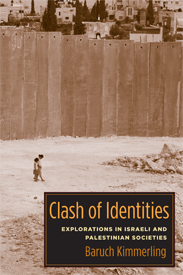|
Reviewed by Pamela Long, Ph.D., Associate Professor of International Studies at Auburn University-Montgomery Born in 1939 Romania, the late Baruch Kimmerling was a prolific essayist, scholar and critic of Israeli political and social structures. As a professor of sociology at both the Hebrew University of Jerusalem and Toronto University, his scholarly publications and activities were often acerbic in their tone, challenging all segments of the Israeli society to question the official history of the communal conflicts. Kimmerling was an ardent atheist, who decried Israel’s failure to unite its citizenry above religious identities, denouncing in his controversial book Politicide: Ariel Sharon’s War against the Palestinians, “a gradual but systematic attempt to cause Palestinians’ annihilation as an independent social, political and economic entity.” Clash of Identities is a compilation of twelve previously published articles, plus an epilogue which attempts, not so much to update the perspectives of his previous works, but rather to summarize the various political events that led to the creation of the current Israeli and Palestinian identities. The articles follow the theme of Kimmerling’s work through the years, which is based on his belief that identity politics define the ongoing Israeli-Palestinian conflict. Kimmerling defines the conflict between the Israeli Jewish majority and the Palestinian minority as essentially an opposition of identities: the Israeli identity (or at least that which the Israeli state has attempted to mold through public discourse) vacillates between the poles of power and anxiety. On the one hand, he says, the Israeli state must classify itself as a “strong” state with the ability to enforce its borders and mobilize its citizenry in effective self-defense. On the other hand, Israelis experience a constant state of anxiety, as victims of rival groups within its society, and foreign states and entities beyond its border, and perceive themselves as overburdened by the responsibility of self-defense. Thus most Israelis in the 1980s concluded that indirect control over the Palestinian population, by military and political authorities, was cheaper and more effective. The rise of the Palestinian Authority during the Oslo Accords, and its failure to “deliver” on the promise of internal security, has caused Israelis to recede from their previously cautious acceptance of the “millet system,” and may be a precursor of events that have taken place since the publication of the book. Kimmerling is less clear in his explanation of the source of Arab-Palestinian identity. Positioning the Arabs of Palestine in a fulcrum between a Pan-Arabism on the one hand and a systematic de-Palestinization on the other, Kimmerling’s theories on the root source of the Arab-Palestinian identity are never fully realized in these essays. In addition to the self-defining identities, another contributing factor in the Israeli-Palestinian struggle is the conflict between the rationalizing narratives of the disparate collectivities. If the official Jewish mythologies of settlement-as-homecoming informs the Israeli identity, then the Arab identity derives from the Muslim mythologies of defense-against-Crusades. Arabs perceive the Jews as modern-day Crusaders, and the Arab peoples await another Saladin to arise to deliver them from their oppressors. While modern Israelis may consider that the Holocaust justifies the “return” as a solution to the “Jewish problem,” Arabs see it as an injustice for which they’ve been made to pay, thus constructing for themselves a victim identity. Furthermore, in terms of national citizenship, Kimmerling argues that Israel’s basic and regular laws posit both a Jewish and a democratic state, continuing the “millet system” of the Ottoman Empire and British colonial state. These “millets” were an accommodation to religious and ethnic communities (such as “halakha” in the Jewish community and “sharia” in the Muslim community), providing a certain degree of autonomy in domestic issues, and limiting the authority of the state to regulate only in crucial areas. Although intended to provide local, community control over indigenous jurisdictions, the system has the effect of subjecting citizens to two separate legal and judicial systems. These presuppositions of identification with ethno-religious communities may leave a large category of “citizens” without full integration into society, and marginalized politically. According to Kimmerling, the axis of nationalism-universalism contained in the “Jewish” and “democratic” identities creates not pluralism and tolerance, but rather an exclusionary construction of citizenship based on Jewish ethnocentrism. As a compilation of Kimmerling’s final work, Clash of Identities provides both admirers and critics with a provocative collection of articles and a useful summation of Kimmerling’s work analyzing the Israeli-Palestinian relations through the lens of identity politics. |


 Clash of Identities: Explorations in Israeli and Palestinian Societies
Clash of Identities: Explorations in Israeli and Palestinian Societies